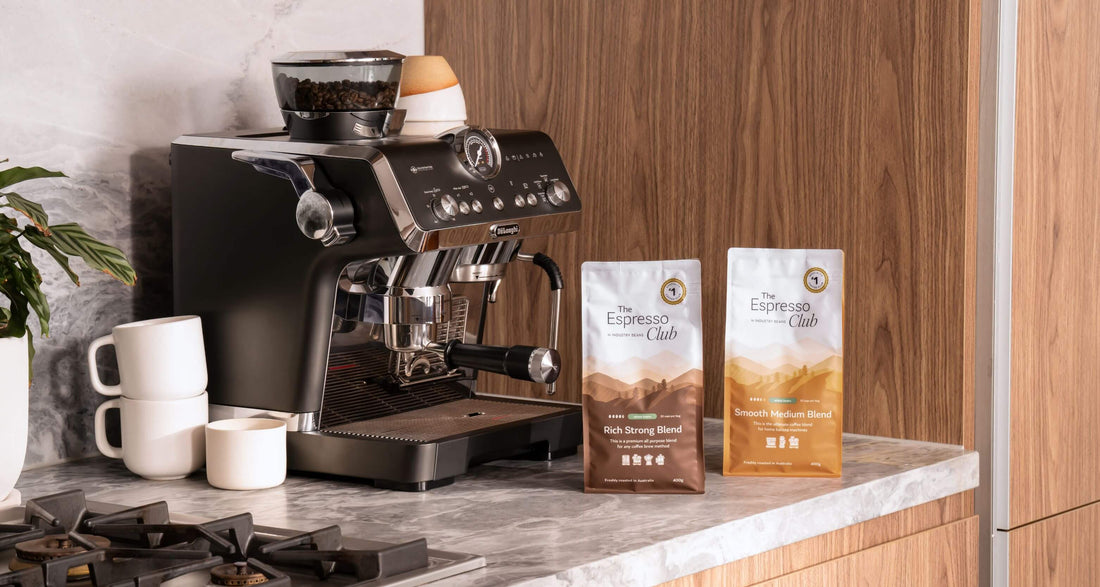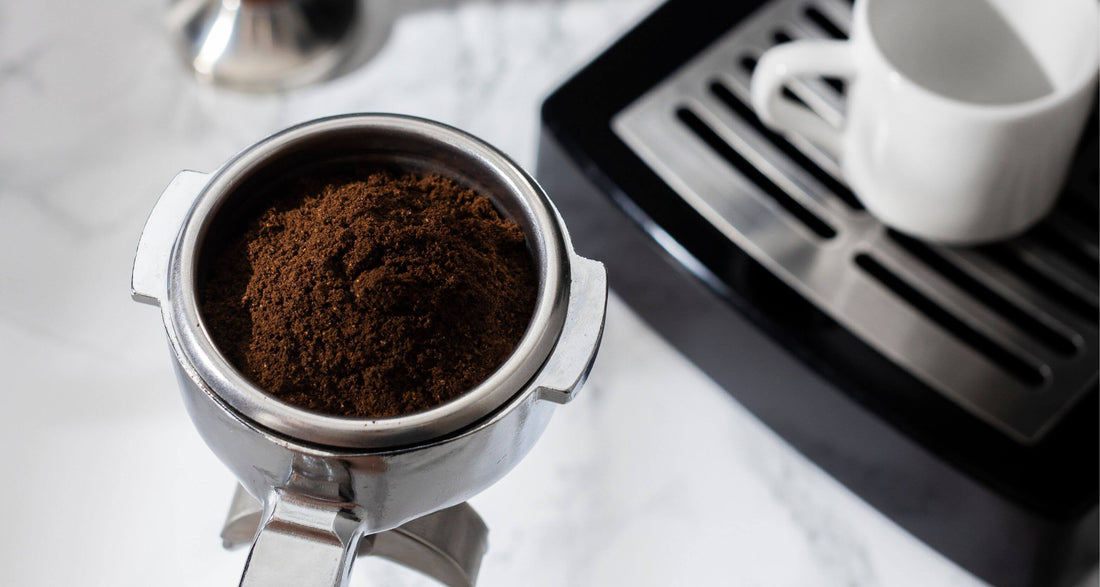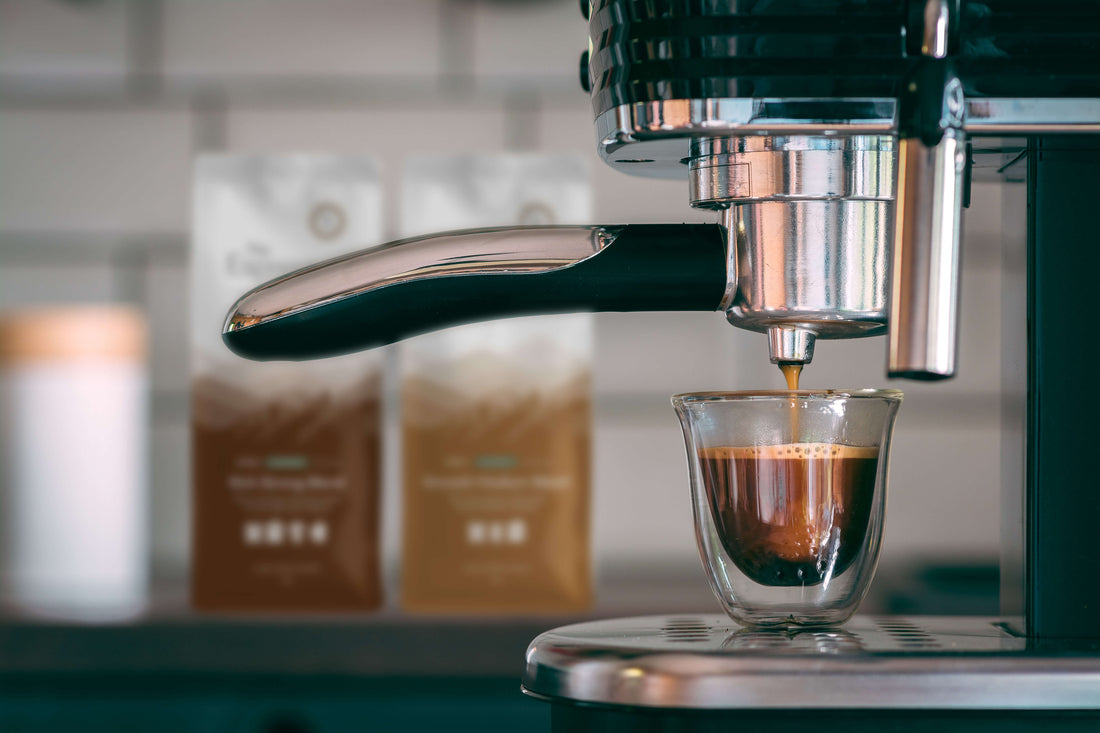Coffee Blog
What Is Crema and Why Does it Matter?
If you’ve ever pulled a shot and noticed a beautiful caramel-coloured layer sitting on top, that’s crema – one of the most recognisable signs of a freshly made espresso. But what actually is crema? Let’s break it down so you can understand what it means for your home espresso. What is crema? Crema is the layer that forms on top of a shot of espresso. It’s created when hot water under pressure meets freshly ground coffee, which releases CO₂ and natural oils that then emulsify and rise to the surface. Think of it like the first impression of your espresso – a sign your beans are fresh and your extraction is working. Why does crema matter? It's a sign of freshness Coffee that has been recently roasted and rested naturally produces more crema because it holds more CO₂. If your beans are very old or stale, crema tends to be thin or disappear quickly. It tells you how your extraction is going Crema can help diagnose what’s happening during your shot, like a little window into your technique. Thick, dark crema: grind may be too fine (over-extraction)Pale, bubbly crema: grind may be too coarse (under-extraction)No crema: beans may be stale or machine pressure too low You don’t need to obsess over it, but it’s a useful indicator when dialling in. It adds texture and aroma Crema carries the aromatic oils that give a shot of espresso its deep, complex smell. It also adds a silky mouthfeel on the first sip, helping your espresso feel rounder and richer. It contributes to the overall flavour Here’s the surprising part: crema isn’t where the sweetest flavours live. In fact, it can be a little bitter. But crema helps: Stabilise the espresso Add body Carry aromas Create that espresso experience you expect from a cafe So while crema isn’t the sole indicator of flavour, it contributes to the overall experience. What affects crema? Your roast level Medium to medium-dark roasts (like Smooth Medium and Rich Strong) will have a balanced crema. Very dark roasts will have thinner, darker crema and very light roasts will have a pale, finer crema. Your machine pressure Home machines produce crema differently than commercial machines. Because our beans are roasted specifically for home machine pressure levels, you'll naturally get a more stable, reliable crema. Your grind size Too coarse will mean a weak crema, while too fine will yield a dark, thick crema, but have a bitter taste. We're aiming for just right: a warm golden crema with balanced flavour. Roast date of your beans If your crema suddenly disappears, your beans may simply be past their peak. How to get better crema at home Use beans made for home espresso Coffee roasted for commercial machines doesn’t extract the same way at home. Both of our blends are tailored for home machine pressure, meaning easier crema and smoother results. Dial in your grind Start fine and adjust until you hit a 25–30 second extraction. See our guide on how to perfect your espresso at home. Keep your machine clean Old coffee oils can affect crema formation. Wipe your basket, purge your steam wand, and backflush regularly. While it’s not the only measure of good espresso, crema is a beautiful sign your beans, grind, and machine are working together. And when you’re using blends roasted specifically for home machines – like Smooth Medium and Rich Strong – getting that velvety, golden layer becomes much easier. Ready for better results at home? You can find The Espresso Club™ at your local Woolworths or shop online anytime. Shop Coffee
Learn moreUnder-Extraction vs Over-Extraction vs Just Right
If you’ve ever sipped a coffee made at home that felt too sour or too bitter, chances are it wasn’t your machine – it was the extraction. We roast our beans to make home brewing easier; but even with beans roasted for home machines, small changes in grind, timing, or tamping can shift your coffee from delicious to bitter!. What is extraction? Extraction is simply how much of the coffee’s flavour is pulled out by water as it passes through the grounds. Under-extracted → not enough flavour is drawn out Over-extracted → too much is drawn out Just right → balanced, smooth, and satisfying A Closer Look At Under-Extraction What it tastes like: Sour, tangy, or sharp Watery or thin in texture Sometimes salty or hollow Why it happens: Grind is too coarse Brew time is too short Water passes through too quickly How to fix it: Try a finer grind Extend your extraction time Make sure you’re using enough coffee (around 18g for a double shot) A Closer Look At Over-Extraction What it tastes like: Bitter or burnt Harsh and dry on the finish Sometimes overly strong but unpleasant Why it happens: Grind is too fine Brew time is too long Water lingers too much in the puck How to fix it: Try a coarser grind Keep extractions under 30 seconds Check you’re not overdosing coffee into the basket So... What Should a Well Extracted Shot Look Like? What it tastes like: Balanced, smooth, and sweet Chocolate or caramel notes come through Pleasant acidity, no harshness How to get there: Aim for 18g coffee in, 36g out in 25–30 seconds Tamp evenly with steady pressure Use beans roasted for home machines (like ours!) for more forgiving, consistent results. Hopefully this helps! And if you're in need of more beans - you know what to do... Shop Coffee
Learn more3 Signs You’re Tamping Wrong (And How to Fix It)
Tamping might seem like a small step in the espresso-making process, but it plays a big role in how your coffee extracts and ultimately, how it tastes. At The Espresso Club™, we design our blends to perform beautifully at home, but if your shots are inconsistent, too fast, too slow or just not quite right, your tamping technique could be the culprit. Here are 3 common signs you might be tamping wrong and what to do about it. 1. Your espresso is running unevenly What it looks like: The shot starts pouring from one side of the spouts or comes out in a thin, uneven stream. What’s happening: You may have tamped unevenly, meaning one side of the puck is more compressed than the other. This causes water to flow through the coffee unevenly, leading to an unbalanced flavour (and a frustrating mess). How to fix it: Make sure your tamp is flat and level. Tamp with your wrist straight and elbow above the portafilter (your arm should almost be in an L-shape). Check from eye level if the coffee bed looks level before and after tamping. 2. The shot runs too fast (or tastes weak and sour) What it looks like: Your espresso starts almost instantly and finishes in under 20 seconds, and it tastes sharp, watery, or underwhelming. What’s happening: Either your grind is too coarse, or your tamp wasn’t firm enough, letting water rush through too quickly and under-extracting the coffee. How to fix it: Tamp firmly with even pressure. Use your full arm, not just your wrist, to apply pressure. If you're already tamping well, try adjusting your grind finer. 3. Your puck is cracked or stuck to the shower screen What it looks like: After brewing, the coffee puck is stuck, has broken apart, or shows a crack through the middle. What’s happening: You may be tamping too hard or using too much coffee. Over-compression can cause channeling or even damage your machine over time. How to fix it: Use the right dose. For most home espresso machines, that’s around 18g for a double shot. Tamp firmly but not forcefully (you want compression, not compaction). If the puck is consistently stuck, check your shower screen or try reducing your dose slightly. Perfect tamping doesn’t require barista training It just needs a little consistency, and beans that are designed to work with home equipment. Our Smooth Medium and Rich Strong blends are roasted for home espresso machines, meaning they’re more forgiving of small technique variations and easier to extract well. So even if your tamp isn’t perfect, your espresso still can be. If you’re tamping level, firm, and consistent, you’re doing it right. And with the right beans, everything else gets easier. Now available at Woolworths You can grab both our Smooth Medium and Rich Strong blends at your local Woolworths. Or, Shop Online
Learn moreHow To Dial In Your Espresso Machine
If you’ve ever brewed an espresso that tasted too sour, too bitter, or just…off, you’re not alone. One of the most important steps in making great coffee at home is learning how to “dial in” your machine. At The Espresso Club™, we make beans specifically for home espresso machines, and we’re here to help you get the most out of them. Whether you’re just starting out or refining your setup, this guide breaks it all down. What Does “Dialling In” Mean? Dialling in means adjusting your grind size, dose, and extraction time until your espresso tastes balanced. The goal? A shot that’s smooth, rich, and full of flavour – just the way you like it. Why It’s Important At Home Home espresso machines don’t have the same pressure or consistency as commercial cafe setups, which means your coffee needs to be just right to get a good extraction. That’s why The Espresso Club™ blends are roasted specifically for home conditions and why dialling in is such a game-changer. The 5 Key Steps to Dial In Your Espresso at Home 1. Start with the right doseUse 18g of coffee for a double shot. We recommend weighing your dose with a small digital scale to keep things consistent. 2. Grind fine (but not too fine)You want your grind to be somewhere between flour and sand. Too fine may mean over-extracted and bitter. Too coarse and you're looking at a shot that's under-extracted and sour. Start with a fine grind and adjust from there. 3. Tamp flat and firmUse even pressure to tamp your coffee down flat. Uneven tamping causes uneven extraction, which can throw off your flavour. 4. Aim for a 25-30 second extractionStart your shot and time it from the moment the espresso begins to pour. Your target is 25–30 seconds for a double shot (36–40g out). If it runs too fast? Grind finer.If it runs too slow? Grind coarser. 5. Taste and adjustYour taste buds are your best tool. If your shot tastes sharp, sour or acidic, it’s likely under-extracted, meaning the water passed through the coffee too quickly and didn’t pull out enough of the flavour. If it’s harsh or overly bitter, it might be over-extracted – the water has been in contact with the coffee too long, drawing out too much and leaving an unpleasant aftertaste. Small tweaks to your grind size, dose, or brew time can make a big difference. Taste, adjust, and find your sweet spot. Pro Tip: Use Beans Made for Home Machines Your coffee can only be as good as your beans, and most aren’t designed to perform in home setups. The Espresso Club™ blends are roasted specifically for home espresso machines: that means better extraction, more consistent results, and less trial and error. Now available at Woolworths You can grab both our Smooth Medium and Rich Strong blends at your local Woolworths. Or, Shop Online
Learn more




